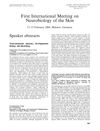Circulating Testosterone and Feather-Gene Expression of Receptors and Metabolic Enzymes in Relation to Melanin-Based Coloration in the Barn Owl
September 2017
in “
General and comparative endocrinology
”
TLDR Barn owls with smaller black spots have higher testosterone levels, which might be due to genetic effects on hormone regulation rather than hormone effects on coloration.
The study on barn owls (Tyto alba) examined the relationship between circulating testosterone and melanin-based traits, specifically the reddish-brown pheomelanin and black eumelanin spots. It found that nestling males had higher testosterone levels than females, and small-spotted males had more testosterone than large-spotted males. However, the relationship between testosterone and spot size in females was not significant. The study concluded that the co-variation between testosterone and melanin-based traits could be negative and is influenced by which sex is more melanic. Additionally, the metabolism of testosterone in tissues where melanogenesis occurs is crucial for understanding its role in color variation.



